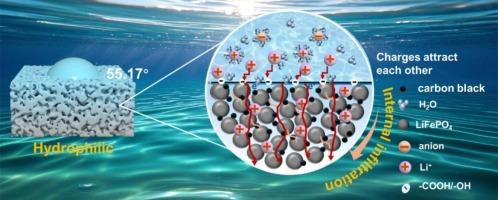Efficient lithium extraction from salt lakes brine via regulating the electric double-layer interface of high-loading film electrodes with CMCLi
IF 9.8
1区 工程技术
Q1 ENGINEERING, CHEMICAL
引用次数: 0
Abstract
In response to the problems of large interfacial diffusion resistance and low lithium extraction efficiency in traditional high-loading film electrodes during lithium extraction from salt lakes by the electrochemical de-intercalation method, this paper presents an interfacial engineering strategy based on the carboxymethyl cellulose lithium (CMC![]() Li) binder. By modulating the structure of the inner Helmholtz plane (IHP) of the electrical double layer and enlarging the effective specific surface area, the migration rate of Li+ and the lithium extraction efficiency are remarkably enhanced.
Li) binder. By modulating the structure of the inner Helmholtz plane (IHP) of the electrical double layer and enlarging the effective specific surface area, the migration rate of Li+ and the lithium extraction efficiency are remarkably enhanced.
In this study, a CMC-Li composite electrode sheet was prepared using Spent LiFePO4 as the raw material. It was demonstrated that the carboxyl (-COOH) and hydroxyl (-OH) functional groups of CMC-Li can be directionally adsorbed on the electrode surface. This adsorption event reconstructs the IHP-layer structure, reduces the solvation energy barrier of Li+, and increases the effective specific surface area of the film electrode. As a result, the contact angle decreased from 130.01° to 55.17°. Furthermore, in the CMC-Li system, the lithium extraction rate in simulated brine increased from 0.33 mg·g−1·min−1 to 0.69 mg·g−1·min−1, while the energy consumption decreased by a factor of 3. In the West Taijinar brine, the lithium extraction capacity reached 23.01 mg·g−1 with a concurrent dramatic reduction in the Mg/Li ratio from 141 to 0.42. These results indicate that the CMC-Li system exhibits excellent lithium extraction performance and high selectivity. Overall, this study proposes a groundbreaking interfacial design concept that achieves both high efficiency and sustainability for lithium extraction from salt lake brines.

利用CMCLi调节高负载膜电极双电层界面,从盐湖卤水中高效提取锂
针对传统高负载膜电极在电化学脱插法提取盐湖锂时界面扩散阻力大、锂萃取效率低的问题,提出了一种基于羧甲基纤维素锂(CMCLi)粘结剂的界面工程策略。通过调节电双层内亥姆霍兹面(IHP)的结构,增大有效比表面积,可以显著提高锂离子的迁移速率和锂离子的萃取效率。本研究以废LiFePO4为原料制备了CMC-Li复合电极片。结果表明,CMC-Li的羧基(-COOH)和羟基(-OH)官能团可以定向吸附在电极表面。该吸附事件重构了ihp层结构,降低了Li+的溶剂化能垒,增加了膜电极的有效比表面积。接触角由130.01°减小到55.17°。在CMC-Li体系中,模拟盐水中锂的提取率从0.33 mg·g−1·min−1提高到0.69 mg·g−1·min−1,而能量消耗降低了3倍。在台湾西部卤水中,锂的萃取量达到23.01 mg·g−1,同时mg /Li比值从141下降到0.42。结果表明,CMC-Li体系具有优异的锂萃取性能和高选择性。总的来说,本研究提出了一个突破性的界面设计概念,实现了从盐湖盐水中提取锂的高效率和可持续性。
本文章由计算机程序翻译,如有差异,请以英文原文为准。
求助全文
约1分钟内获得全文
求助全文
来源期刊

Desalination
工程技术-工程:化工
CiteScore
14.60
自引率
20.20%
发文量
619
审稿时长
41 days
期刊介绍:
Desalination is a scholarly journal that focuses on the field of desalination materials, processes, and associated technologies. It encompasses a wide range of disciplines and aims to publish exceptional papers in this area.
The journal invites submissions that explicitly revolve around water desalting and its applications to various sources such as seawater, groundwater, and wastewater. It particularly encourages research on diverse desalination methods including thermal, membrane, sorption, and hybrid processes.
By providing a platform for innovative studies, Desalination aims to advance the understanding and development of desalination technologies, promoting sustainable solutions for water scarcity challenges.
 求助内容:
求助内容: 应助结果提醒方式:
应助结果提醒方式:


